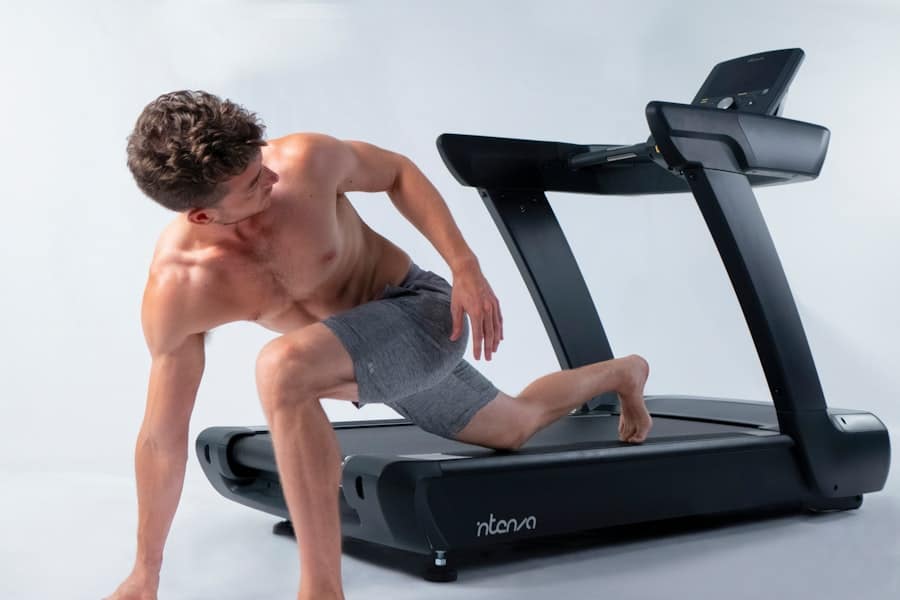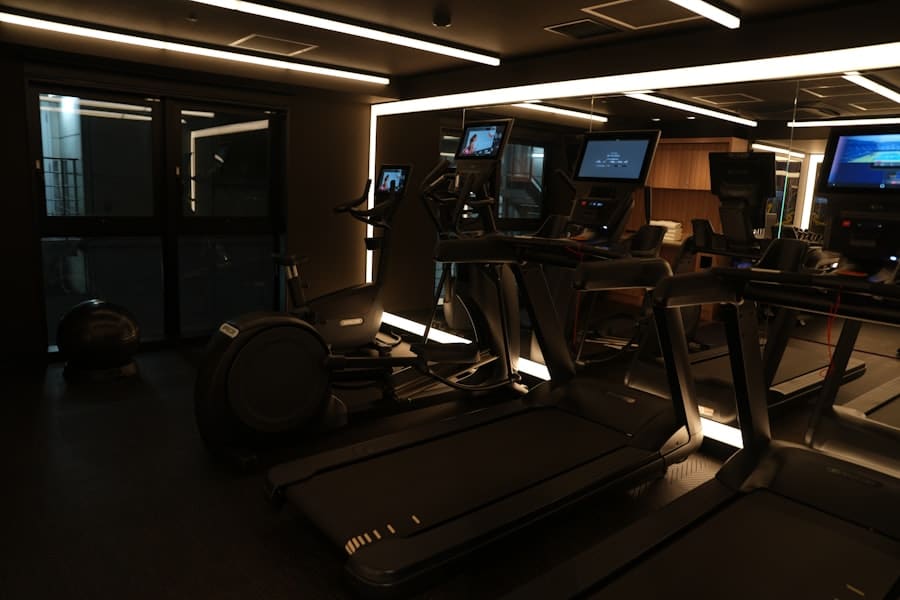The Internet of Things (IoT) has revolutionized various sectors, and the fitness industry is no exception. IoT-connected gym equipment refers to fitness machines and devices that are embedded with sensors, software, and connectivity capabilities, allowing them to communicate with other devices and systems over the internet. This technology enables users to track their workouts, monitor their progress, and receive personalized feedback in real-time.
As more individuals seek to enhance their home fitness experiences, the demand for smart gym equipment has surged, leading to a proliferation of innovative products designed to cater to diverse fitness needs.
For instance, smart treadmills can adjust their incline and speed based on the user’s performance, while connected stationary bikes can simulate outdoor cycling routes.
This level of interactivity not only makes workouts more enjoyable but also encourages users to stay committed to their fitness goals. As the landscape of home fitness continues to evolve, understanding the implications of IoT-connected gym equipment becomes essential for anyone looking to optimize their exercise regimen.
Key Takeaways
- IoT-connected gym equipment allows for seamless integration with other devices and apps, making it easier to track and monitor workouts.
- The benefits of IoT-connected gym equipment for home fitness include personalized fitness routines, real-time feedback, and the ability to track progress over time.
- IoT-connected gym equipment tracks and monitors workouts through sensors and data collection, providing valuable insights into performance and progress.
- IoT-connected gym equipment plays a crucial role in personalized fitness routines by adjusting settings and providing tailored workout recommendations based on individual data.
- The integration of IoT-connected gym equipment with fitness apps and wearable devices allows for a comprehensive and holistic approach to home fitness, enabling users to track and analyze their workouts in real time.
The Benefits of IoT-Connected Gym Equipment for Home Fitness
One of the most significant advantages of IoT-connected gym equipment is its ability to provide real-time feedback and performance analytics. Users can access detailed metrics such as heart rate, calories burned, and workout duration through connected apps or displays on the equipment itself. This immediate feedback allows individuals to adjust their workouts on the fly, ensuring they are maximizing their efforts and achieving optimal results.
For example, a smart rowing machine can provide insights into stroke efficiency and power output, enabling users to refine their technique and improve overall performance.
Many devices come equipped with social features that allow users to share their progress with friends or join virtual communities.
This social aspect can be a powerful motivator, as individuals are more likely to stick to their fitness routines when they feel supported by others. Additionally, some equipment offers gamification elements, such as challenges and rewards, which can further enhance user engagement. By creating a more interactive and community-driven experience, IoT-connected gym equipment helps individuals maintain their commitment to fitness.
How IoT-Connected Gym Equipment Tracks and Monitors Workouts

The tracking capabilities of IoT-connected gym equipment are one of its most compelling features. These devices utilize various sensors and technologies to monitor a wide range of workout parameters. For instance, many smart treadmills are equipped with accelerometers that measure speed and distance, while smart weights can detect the amount of weight being lifted and the number of repetitions performed.
This data is then transmitted to connected apps or cloud-based platforms for analysis. In addition to basic metrics, advanced IoT-connected equipment can also track biometric data such as heart rate variability and oxygen saturation levels. This information is invaluable for users looking to optimize their training intensity and recovery strategies.
For example, a smart bike may adjust its resistance based on the user’s heart rate, ensuring that they remain within their target training zone. By providing comprehensive insights into both performance and physiological responses, IoT-connected gym equipment empowers users to make informed decisions about their fitness journeys.
The Role of IoT-Connected Gym Equipment in Personalized Fitness Routines
Personalization is a key trend in the fitness industry, and IoT-connected gym equipment plays a pivotal role in tailoring workouts to individual needs. Many devices come with built-in algorithms that analyze user data to create customized workout plans based on fitness levels, goals, and preferences. For instance, a smart elliptical may suggest specific resistance levels and workout durations based on the user’s previous performance data and stated objectives.
Furthermore, the adaptability of IoT-connected equipment allows for dynamic adjustments during workouts. If a user is struggling with a particular exercise or is not achieving desired results, the system can modify the workout in real-time. This level of personalization not only enhances the effectiveness of training but also helps prevent injuries by ensuring that users are not overexerting themselves or performing exercises incorrectly.
As a result, individuals can enjoy a more efficient and safer workout experience tailored specifically to their unique fitness journeys.
The Integration of IoT-Connected Gym Equipment with Fitness Apps and Wearable Devices
The synergy between IoT-connected gym equipment and fitness apps or wearable devices creates a comprehensive ecosystem for health and wellness management. Many smart gym machines are designed to seamlessly integrate with popular fitness applications, allowing users to sync their workout data across multiple platforms. This integration enables individuals to have a holistic view of their fitness progress, combining data from various sources such as heart rate monitors, smartwatches, and nutrition tracking apps.
For example, a user might complete a workout on a connected treadmill while wearing a smartwatch that tracks heart rate and calories burned. After the session, all data can be aggregated into a single app that provides insights into overall performance trends over time. This interconnectedness not only simplifies data management but also enhances motivation by allowing users to set goals across different aspects of their health journey.
The ability to visualize progress through comprehensive dashboards can significantly boost adherence to fitness routines.
The Future of IoT-Connected Gym Equipment in Home Fitness

Enhanced User Experiences
Future devices will utilize AI algorithms to offer more precise guidance, helping users achieve their fitness goals more efficiently. This technology will also enable real-time feedback and adjustments, ensuring that users are always challenged and motivated.
Immersive Fitness Experiences
Advancements in virtual and augmented reality will further transform home fitness experiences. Imagine using an AR headset while working out on a smart bike, transporting you through scenic landscapes or competitive cycling events in real-time. These immersive experiences will make home workouts more engaging and enjoyable, while still benefiting from the data-driven insights provided by IoT technology.
Redefining Home Fitness
As these technologies converge, they will likely redefine how individuals approach fitness at home. With IoT-connected gym equipment, users will have access to a more personalized, engaging, and effective fitness experience, revolutionizing the way we approach our health and wellness.
Considerations for Choosing IoT-Connected Gym Equipment for Home Use
When selecting IoT-connected gym equipment for home use, several factors should be taken into account to ensure that the investment aligns with personal fitness goals and lifestyle preferences. First and foremost is compatibility with existing devices and apps; users should verify that the equipment can seamlessly integrate with their preferred fitness platforms or wearables. This compatibility ensures that all data can be easily tracked and analyzed in one place.
Another critical consideration is the type of workouts one intends to perform. Different pieces of equipment cater to various fitness modalities—whether it’s strength training, cardio workouts, or flexibility exercises—so it’s essential to choose machines that align with personal interests and goals. Additionally, factors such as space availability in the home environment should be evaluated; some smart gym machines are designed for compact living spaces while still offering robust functionality.
Finally, budget constraints will also play a significant role in decision-making; while many high-end options offer advanced features, there are also budget-friendly alternatives that provide essential connectivity without breaking the bank.
The Impact of IoT-Connected Gym Equipment on the Future of Home Fitness
The emergence of IoT-connected gym equipment has fundamentally altered the landscape of home fitness by making workouts more interactive, personalized, and data-driven than ever before. As technology continues to evolve, these devices will likely become even more sophisticated, offering enhanced features that cater to diverse user needs. The ability to track performance metrics in real-time, receive personalized feedback, and integrate seamlessly with other health management tools positions IoT-connected gym equipment as an essential component of modern fitness regimens.
As individuals increasingly prioritize health and wellness in their lives, the role of technology in facilitating effective home workouts will only grow in importance. By embracing IoT-connected gym equipment, users can not only achieve their fitness goals but also enjoy a more engaging and supportive exercise experience tailored specifically for them. The future of home fitness is bright, driven by innovation and connectivity that empowers individuals on their unique health journeys.
If you are interested in incorporating technology into your fitness routine, you may also want to check out this article on the best software for NDIS providers. Just like IoT-connected gym equipment is revolutionizing home fitness, the right software can streamline processes and improve efficiency for NDIS providers. Embracing technology in various aspects of our lives can lead to more convenience and effectiveness in achieving our goals.
FAQs
What is IoT-connected gym equipment?
IoT-connected gym equipment refers to fitness machines and devices that are equipped with sensors and connectivity capabilities to collect and transmit data. This data can include workout metrics, user performance, and equipment status.
How does IoT-connected gym equipment work?
IoT-connected gym equipment uses sensors to collect data on user activity and machine performance. This data is then transmitted to a central system or cloud platform where it can be analyzed and used to track workouts, monitor equipment maintenance needs, and provide personalized fitness recommendations.
What are the benefits of IoT-connected gym equipment for home fitness?
The benefits of IoT-connected gym equipment for home fitness include real-time workout tracking, personalized training programs, remote equipment monitoring and maintenance, and the ability to connect with fitness apps and wearable devices for a seamless fitness experience.
How does IoT-connected gym equipment improve the home fitness experience?
IoT-connected gym equipment improves the home fitness experience by providing users with access to advanced workout tracking and analysis, personalized training programs, and the ability to seamlessly integrate their fitness data with other devices and platforms for a comprehensive fitness experience.
What are some examples of IoT-connected gym equipment for home fitness?
Examples of IoT-connected gym equipment for home fitness include smart treadmills, connected stationary bikes, sensor-equipped strength training machines, and wearable fitness trackers that can sync with home gym equipment for a fully integrated workout experience.

